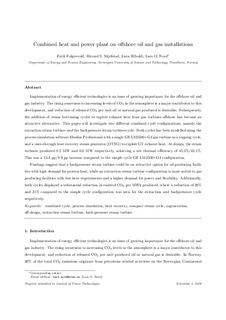Combined heat and power plant on offshore oil and gas installations
Journal article, Peer reviewed

Åpne
Permanent lenke
http://hdl.handle.net/11250/2434093Utgivelsesdato
2016Metadata
Vis full innførselSamlinger
Sammendrag
Implementation of energy efficient technologies is an issue of growing importance for the offshore oil and gas industry. The rising awareness to increasing levels of CO2 in the atmosphere is a major contributor to this development, and reduction of released CO2 per unit oil or natural gas produced is desirable. Subsequently, the addition of steam bottoming cycles to exploit exhaust heat from gas turbines offshore has become an attractive alternative. This paper will investigate two different combined cycle configurations, namely the extraction steam turbine- and the backpressure steam turbine-cycle. Both cycles has been modelled using the process simulation software Ebsilon Professional with a single GE LM2500+G4 gas turbine as a topping cycle, and a once-through heat recovery steam generator (OTSG) to exploit GT exhaust heat. At design, the steam turbines produced 8.2 MW and 6.0 MW respectively, achieving a net thermal efficiency of 45.5%/42.1%. This was a 12.3 pp/8.9 pp increase compared to the simple cycle GE LM2500+G4 configuration.
Findings suggest that a backpressure steam turbine could be an attractive option for oil producing facilities with high demand for process heat, while an extraction steam turbine configuration is more suited to gas producing facilities with less heat requirements and a higher demand for power and flexibility. Additionally, both cycles displayed a substantial reduction in emitted CO2 per MWh produced, where a reduction of 26% and 21% compared to the simple cycle configuration was seen for the extraction and backpressure cycle respectively.